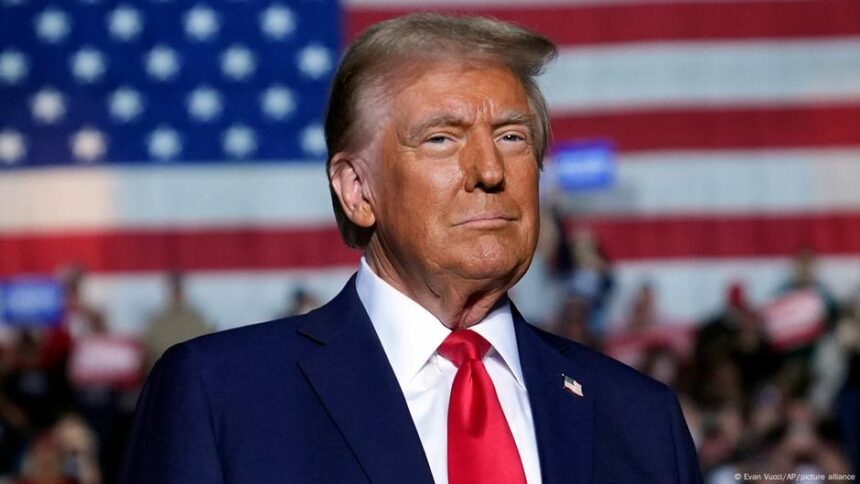US Tariffs: The President Donald Trump’s trade war with China continues to escalate, American ports, especially those on the West Coast, are beginning to show signs of a deepening economic slowdown. At the Port of Los Angeles, one of the busiest docks in the United States, the once-bustling activity has drastically slowed. “You could hear a pin drop, it’s very unusual,” remarked Gene Seroka, the Port Director, in a rare moment of reflection on what has become a growing crisis affecting the entire U.S. economy.
The Port of Los Angeles, along with the Port of Long Beach, serves as one of the primary gateways for goods from China and other Asian countries. As a result, the slowdown at these ports offers a first-hand glimpse into the broader impact of Trump’s tariffs on the American economy. These tariffs, which range up to 145 percent on some products, have left a significant mark on U.S. imports, particularly from China, which has long been the largest supplier of goods to the country.
Also Read: Trump’s Tariff War Faces Intense Challenges, Economists Warn
The Port of Los Angeles is expected to handle up to 35% fewer shipments than the same time last year. Meanwhile, the Port of Long Beach anticipates a 30% drop in imports for the entire month of May. Dozens of shipping vessels have already cancelled their voyages to these ports, with both retailers and manufacturers “hitting the pause button” on orders. According to Seroka, many businesses have completely halted shipments from China, pointing to a deeper economic disruption that could affect consumers nationwide.
The Impact of Rising Tariffs
The economic consequences of these tariffs are starting to become more apparent. As Chinese goods flood the U.S. market, prices are rising sharply, and retail shelves are slowly emptying. “Effectively, the cost of a product made in China now is two and a half times more expensive than it was just last month,” Seroka explained. With the cost of many everyday goods skyrocketing, the already burdened American consumer is poised to feel the squeeze even more.
The tariffs have also had a ripple effect on global trade. Last month, Trump announced a series of fluctuating tariffs against various countries, including nations with minimal trade ties to the U.S., such as an island populated mostly by penguins. Economists were baffled by the unpredictability of these measures. Later, the White House settled on a blanket 10 percent tariff on goods from most of the world, a decision that continues to rattle businesses.
Read More: UAE Eases Penalties for Late Corporate Tax Registration
The weight of these tariffs falls on U.S. importers, who bear the brunt of the additional costs. This has led to growing frustration, particularly from the retail sector, where supply chains are already stretched thin. “This is not just a West Coast issue,” warned Mario Cordero, the Director of the Port of Long Beach. The problem extends to ports across the entire country, from the East Coast to the Gulf of America, which Trump has notably rebranded.
A Precursor to Shortages and Higher Prices
The fallout from Trump’s trade policies has sparked a rush at ports earlier in the year, as American companies scrambled to import goods before tariffs were fully implemented. Cargo volumes surged in an attempt to build up stockpiles before the full effects of the tariffs hit. But as tariffs continue to bite, companies are slowing their purchases, and inventory is beginning to dwindle.
Port Directors are now warning that this could lead to shortages, and consumers will soon feel the consequences. “American importers, especially in the retail sector, are telling me that they have about five to seven weeks of normal inventory on hand today,” Seroka said. “If this trade dispute goes on for any length of time, we’ll likely see fewer selections on store shelves and online buying platforms. The impact on American consumers will be less choice and higher prices.”
Working-Class Struggle
For many in the logistics sector, the consequences of Trump’s tariffs have already become a harsh reality. Antonio Montalbo, a small business owner in Southern California, has been hit hard by the rising costs of Chinese-made goods. A part needed to repair one of his trucks has doubled in price due to the tariffs.
As one of the 900,000 logistics workers in Southern California, Montalbo is worried about his future. “We’re angry at Donald Trump,” he said, explaining that the additional costs, coupled with a slowdown in work, may force him to lay off employees within the next six months.
Also Read: UAE to Post Budget Surplus in 2025 Despite Lower Oil Prices
Montalbo, a voter from previous election, expressed his disappointment with the president’s handling of the economy. “I thought that he was a businessman. Now we have something worse than inflation, called tariffs,” Montalbo said, reflecting the growing frustration among many working-class Americans who are feeling the brunt of the ongoing trade dispute.
Economic Uncertainty
The situation at U.S. ports is indicative of a larger economic crisis that continues to unfold. With less cargo arriving, American consumers are bracing for higher prices and fewer product choices.
As the trade war between the U.S. and China drags on, it’s clear that the fallout from Trump’s tariffs is being felt not just on the West Coast, but across the entire nation. The administration will alter its course or continue its tariff policies remains uncertain, but one thing is clear: American consumers are already paying the price.
Follow 10X Times for more business news.






